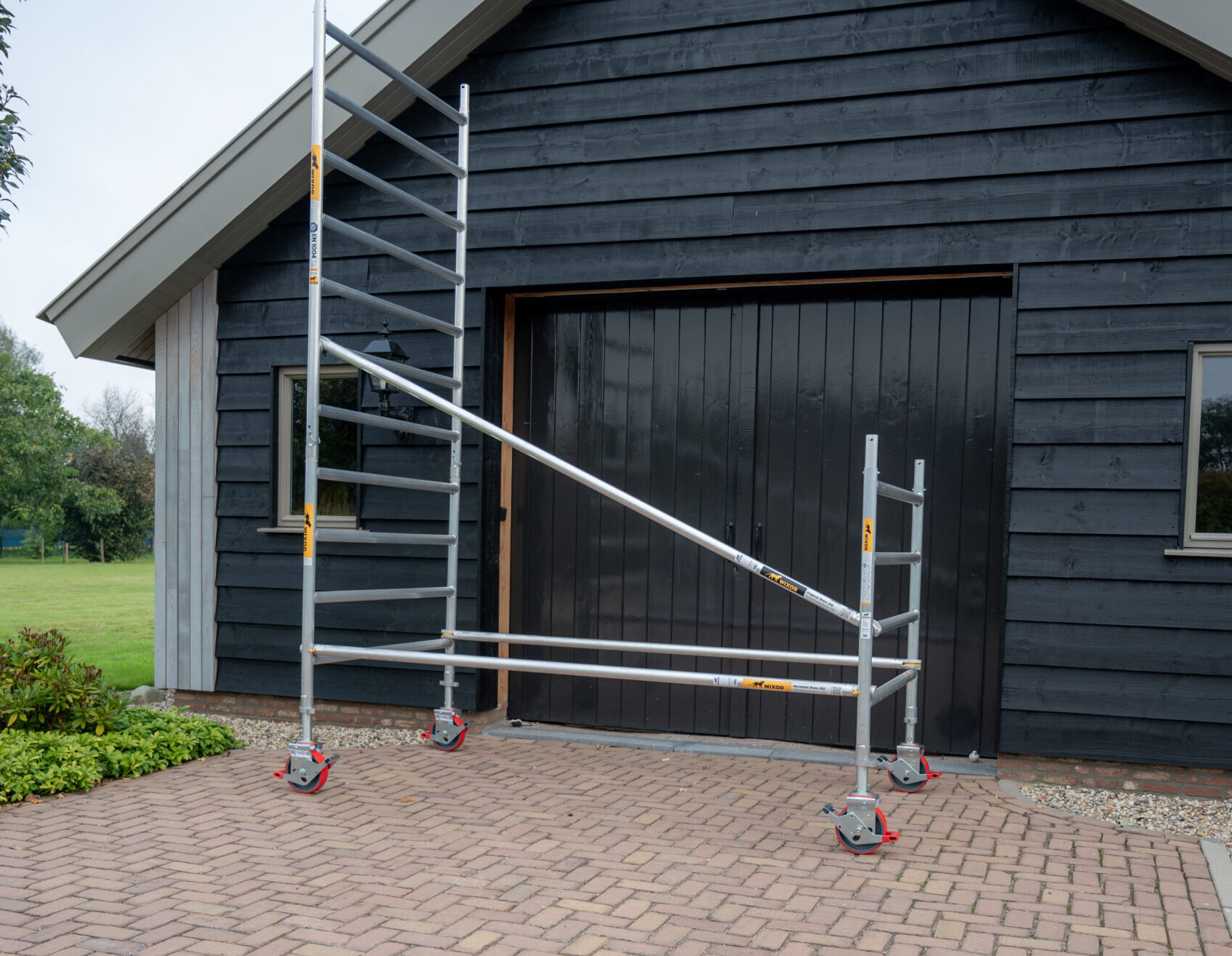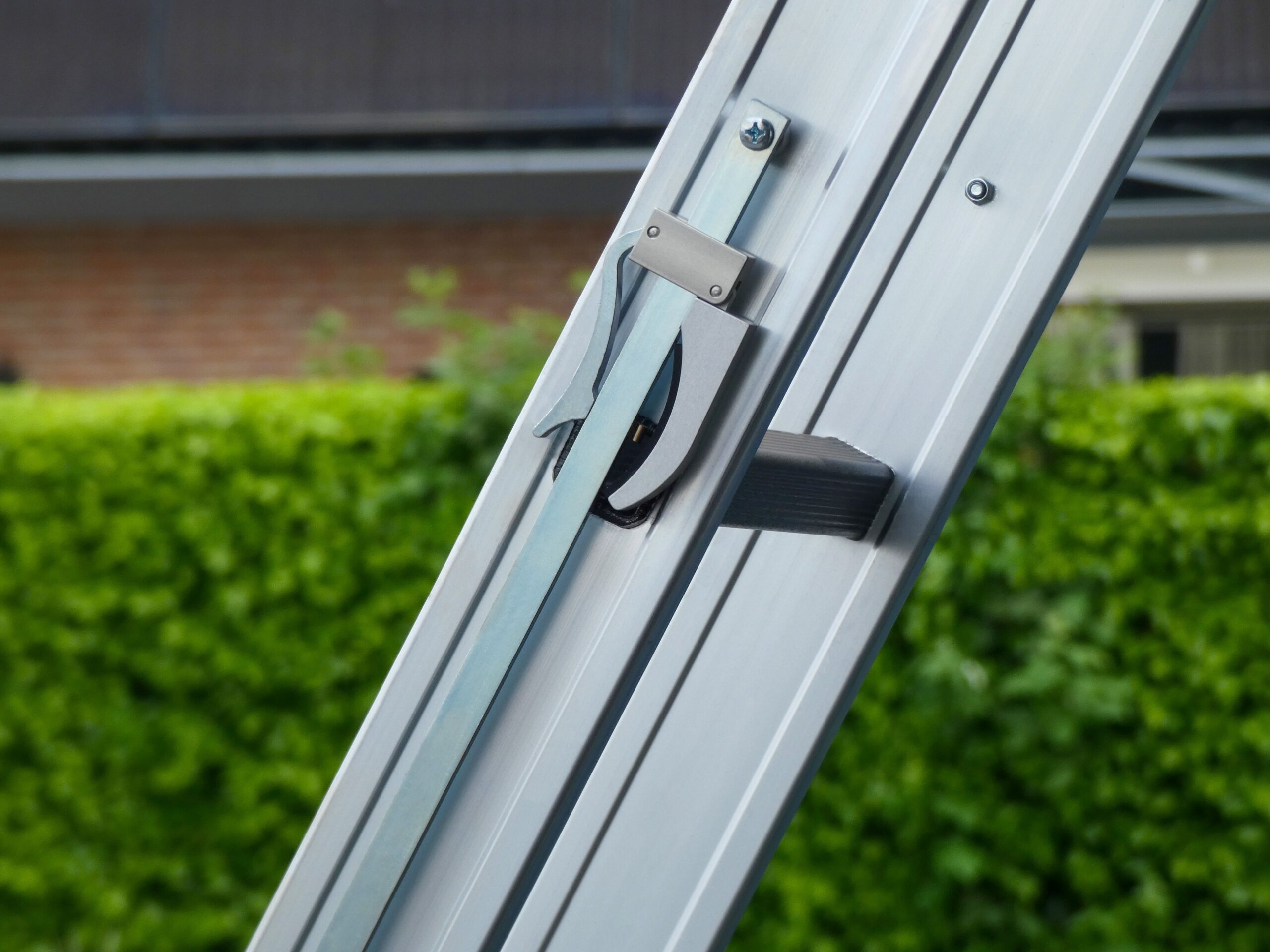How to assemble a mobile scaffold with braces
A mobile scaffold is essential for many high-altitude tasks, both for construction professionals and DIY enthusiasts. The biggest advantage of a mobile scaffold is that you can move and set it up whenever and wherever you need it. Whether you're painting a facade, installing window frames, or cleaning gutters, a mobile scaffold allows you to work stably, safely, and ergonomically.
In this blog by Wixor, we will guide you step by step on how to safely assemble a mobile scaffold. We will first discuss the required scaffold components, then the correct assembly order, and conclude with useful tips and information on purchasing the right scaffold. This way, you can be sure that you're working safely.
What scaffold parts do you need?
Before you start assembling, it’s important to know which parts you need to build a scaffold. A complete mobile scaffold typically consists of the following components:
-
Frames – These are the vertical frames of the mobile scaffold. They form the base on which the rest of the scaffold rests.
-
Platforms – The surfaces you stand on while working. Platforms are available with or without a hatch for easy access to higher levels.
-
Horizontal Braces – These provide stability in width and are used as a guardrail.
-
Diagonal Braces – These reinforce the structure and add extra strength.
-
Stabilizers – These extend the base of the scaffold for added stability.
-
Toeboards – Prevent tools or materials from falling off the platform.
-
Scaffold Wheels – Swivel wheels with brakes that allow you to move the scaffold. Always secure the brakes properly.
Step-by-Step Guide to Assembling a Mobile Scaffold with braces
Assembling a mobile scaffold may seem simple, but safety is the top priority. Follow these steps carefully for correct and secure assembly. Make sure you have checked all required parts in advance.
Step 1: Check the surface
Ensure the groundsurface is leveled, firm, and free of obstacles. If working on soft ground, use special base plates for extra stability.
Step 2: Attach the scaffold wheels
Install the scaffold wheels onto the first two frames. Make sure all wheels are securely attached and leveled. Immediately engage the brakes once the wheels are installed.
Step 3: Assemble the first level
Attach the first assembly frames together using horizontal and diagonal braces. This forms the base of your scaffold. Then place the first platform (with a hatch) at the desired height.
Step 4: Secure the scaffold with braces
Mount diagonal braces in a cross pattern between the frames. Then attach the horizontal braces to the front and back. This is crucial for the stability of the mobile scaffold.
Step 5: Repeat steps 3 and 4
For assembling the higher levels, repeat steps 3 and 4. Use a new scaffold section for each level. Work systematically: first the frames, then the braces, then the platform. Always use a hatch platform for safe climbing within the scaffold.
Step 6: Install the Toe Boards
Once the highest work platform is in place, install the toeboards around it. These are mandatory according to safety regulations and prevent materials from falling.
Step 7: Attach the stabilizers
Secure the stabilizers diagonally from the bottom of the scaffold outward. This prevents tipping. The stabilizers should be attached at the four corners of the scaffold using wing nuts.
Step 8: Inspect the entire scaffold
Check all connections, braces, and wheels. Everything must be firmly secured. Also, ensure that the wheels are properly locked.
Step 9: Climb safely
Only climb the scaffold from the inside, using the hatches. Never climb the outside of the mobile scaffold.
Important Safety Tips
-
Always use a complete scaffold—never improvised solutions.
-
Wear safety shoes and work gloves.
-
Never use the mobile scaffold in strong winds or storms.
-
Never move the scaffold while someone is standing on it.
-
Work with two (or more) people.
At Wixor, we prioritize safety. All our mobile scaffolds comply with current regulations such as EN1004 and are TÜV-certified, making them suitable for professional use.
Buying a Wixor mobile scaffold?
Wixor mobile scaffolds are available through an extensive network of specialized dealers. Our official dealers provide expert advice and can help you assemble a complete mobile scaffold tailored to your work situation.
Need advice or have questions? Contact us!
Do you have questions about assembling a scaffold or are you interested in becoming a Wixor dealer? Feel free to contact us. With the right knowledge, good preparation, and high-quality scaffold components from Wixor, you’ll always work safely at height!
Call us at +31(0)88-3213000
Email us at Info@wixor.com
Or fill out the contact form at https://wixor.com/nl/klantenservice/
Annual ladder inspection
When it comes to the safety and reliability of ladders, an annual inspection is essential. This article discusses the key facts and guidelines for inspecting ladders, emphasizing the necessity of yearly inspections, the specific aspects checked during these inspections, and their implications.
Importance of ladder inspections
Ladders are an essential part of many workplaces, making safety a top priority. Although it's often not mandatory to have a ladder inspected in the first year after purchase, many companies choose to do so. Often, an inspection is performed upon delivery to ensure that the ladder is safe to use from the start. If an inspection is conducted at the time of delivery, it's not required to inspect the ladder again during the first year.
Obligations and frequency of inspections
After the first year of use, ladders must be inspected annually by a certified inspector. This inspection is crucial to ensure that the ladder remains safe and meets the current safety standards. The annual inspection involves a thorough check of the ladder, with various aspects being evaluated.
Inspection for damage
A key part of the annual inspection is checking for damage. The ladder is examined for various types of damage that could affect safety. For instance, the ladder may show a maximum of 0.5% warping or deflection relative to its length, meaning the ladder should not deviate more than 0.5% from its original straight line in both vertical and horizontal directions. Any dents in the ladder rungs must not be deeper than 3mm, and sharp dents are not allowed under any circumstances, as they could lead to fractures or other severe damage.
Inspection for dents in the rails: In addition to the rungs, the ladder's rails are also checked for dents. Dents in the rails must not be deeper than 3mm. If a dent is located in a weak spot, such as outside the neutral axis (the central line that distributes the load), the ladder will be rejected. Dents not on this axis can seriously compromise the ladder's stability.
Checking for wear on rubber feet: The wear on the ladder's rubber feet is another crucial aspect inspected. The rubber feet must have at least 5mm of rubber between the aluminum of the ladder and the contact point on the ground to ensure that the ladder doesn't slip during use and maintains sufficient grip on the surface.
Inspection for cracks: Cracks, including top cracks, must not be present in the ladder. Hairline cracks on the flange edge are allowed as long as they do not extend into the rung. Cracks can weaken the ladder's strength and stability and should be thoroughly inspected and repaired if necessary.
Checking for play: There should be no play in the rungs or ladder fittings. Play could indicate wear or damage, compromising the ladder's stability and safety. It is crucial that all parts are securely fastened without any play. If there is play in the rungs or fittings, the ladder will be rejected and cannot be used until it is repaired.
Inspection for essential components
During the annual inspection, it is also checked whether all essential ladder components are present and in good condition. The extension limit must be present and functioning, as it prevents the ladder from being extended too far, which could cause instability.
The spreader bars, another crucial component, must also be inspected. These bars ensure that the ladder does not unintentionally collapse during use and must be in good working condition with no signs of wear or damage.
Rubber and plastic caps are important for the ladder's safety and stability, and they must be in good condition to prevent the ladder from slipping or damaging the surface. The presence and reinforcement strips on the stabilizer bar are also important, as they provide extra support and stability, especially when using longer ladders.
Implications for companies and employees
For companies, complying with the annual inspection requirements is not just a legal obligation but also a way to ensure safety. A ladder that does not meet safety standards can lead to serious accidents, resulting in disability or legal complications. To avoid this, it is important to meet safety standards and have the ladder inspected annually.
Employees need to trust that the ladders they use are safe and reliable. Regular inspections and maintenance of ladders contribute to creating a safe work environment and prevent accidents. Companies must have their ladders inspected annually to comply with arbo regulations. Management is responsible for ensuring that all ladders are inspected annually and that any defects are immediately addressed.
Procedures for ladder inspection
The ladder inspection process begins with a visual check. The inspector thoroughly examines the ladder to identify any visible damage or wear. This includes checking the rungs, rails, rubber feet, and other ladder components. After the visual inspection, a functional test is performed. The ladder is set up and tested for stability and functionality. The extension limit and spreader bars are checked for their operation and reliability.
If the ladder shows damage or wear that affects safety, it must be repaired or replaced. It's important to note that some types of damage, such as cracks or deep dents, cannot always be repaired. In such cases, the ladder must be taken out of service and replaced with a new one.
Documentation and certification
After the inspection, a detailed inspection report is prepared. This report includes all the inspector's findings, including any defects found and the measures taken to address them. The report serves as proof that the ladder has been inspected and meets safety standards. Additionally, the ladder receives an inspection certificate indicating that it is safe for use. This certificate should be kept in an accessible place so it can be shown during inspections or checks by authorities.
Responsibilities for companies
Companies must comply with arbo legislation. To do so, ladders must be inspected annually. Companies are responsible for arranging the annual inspections and ensuring that all ladders they use meet safety standards. This includes scheduling inspections, maintaining ladders, and ensuring the necessary repairs are made or considering replacing the ladder. Failure to comply with these obligations can result in fines, legal consequences, and increased risks of accidents.
What to do in case of ladder damage
Based on the nature of the damage described in the inspection report, it must be decided whether the ladder can be repaired or needs to be replaced. Minor damage can sometimes be repaired, such as replacing worn rubber feet or adding new caps. After replacing the damaged parts, the ladder can be put back into use. For severe damage, repairs are often not possible, and the ladder must be taken out of service. This usually occurs when there are deep dents, cracks in the rails, or broken rungs, making it unsafe to use the ladder. In such cases, it's best to replace the ladder with a new one.
After repairing a ladder, it is re-inspected for added safety. This re-inspection is thorough, with all repaired components carefully checked for safety and functionality.
Conclusion
The annual inspection of ladders is a crucial part of ensuring workplace safety. Companies are required to have their ladders inspected annually. This rule does not apply to individuals. By having ladders inspected annually by a certified inspector, companies comply with arbo legislation and stringent safety standards. The inspection includes a thorough check for damage, wear, and the presence of essential components. Complying with these inspection requirements is not only a legal obligation but also a way to ensure workplace safety.
By investing in regular ladder inspections and maintenance, companies can prevent serious accidents and create a safer working environment. It is essential that both companies and employees understand the importance of ladder inspections and take responsibility for arranging the inspection. This helps companies avoid fines or other consequences if the ladder is not inspected.


